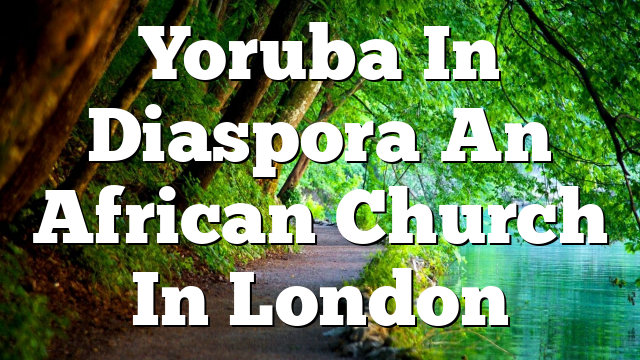Click to join the conversation with over 500,000 Pentecostal believers and scholars
Click to get our FREE MOBILE APP and stay connected
| PentecostalTheology.com



178
Book Reviews / Pneuma 30 (2008) 147-191
Hermione Harris, Yoruba in Diaspora: An African Church in London (New York: Macmillan Palgrave, 2006). ix + 294 pp.
At a time when contemporary anthropological and sociological scholarship on African Christianity has concentrated on multifaceted processes of globalizing Pentecostalism, Hermione Harris’s new book is an important reminder that a fresh understanding of the so-called African Initiated (or Independent/Instituted) Churches (AICs) is necessary in putting African Pentecostalism in proper (global) perspective. The AICs were the pride of African scholarship in the 1960s and 1970s, only to be neglected in the 1980s and 1990s because of the emergent new Pentecostalism that captured the scholarly gaze. Although based on field research initiated in 1969 in London, Yoruba in Diaspora contains materials collected and updated until very recently. This book investigates the lives and modes of being-in-the-world of Yoruba worker-students who were members of the London branch of Cherubim and Seraphim Church (C&S), one of the early AICs originally founded in Nigeria.
The book sets out from the onset to unpack the C&S’s conception and “pursuit of agbara emi, spiritual power” (“unseen energy”), its vitality, and its logic of operation (7). The author contends that the concept of power as vitality is omnipresent among the people of Western Nigeria. The way in which power-as-unseen-energy permeates ritual, prophetic, and divinatory practices of the C&S forms the pivot around which narratives of life histo- ries of prominent members of the London C&S movement revolves.
The first three chapters of the nine-chapter book constitute the historical background upon which the remaining six chapters construct an anthropology of religious/ritual power according to the C&S epistemological praxis. The first chapter describes the origin and rationale of the study, the reasons why it was “abandoned” for more than thirty years before being taken up again in order to fill a gap in the research on the nature of power in Aladura churches, and some of the difficulties experienced in carrying out the research. The second chapter situates the life of Yoruba “worker-students” in the Britain of the late 1960s and early 1970s, their unique dilemmas, predicaments, and aspirations for “public invisibility” (37), and the way these problems functioned as catalysts for bringing them “to C&S proph- ets for prayers” (39). The third chapter briefly sets out the historical origins of the C&S in Nigeria and in the United Kingdom, where it functions “not only [as] a potentially sup- portive social web in London, but [also as] a means of maintaining a Yoruba identity, Nigerian contacts, and an orientation toward home throughout the protracted stay in Brit- ain” (46) and maintaining its “ritual objective: the generation and deployment of spiritual power” (53).
Chapter four begins the exploration of the concepts of spiritual power according to the C&S articulations, examining the transition from As.e (seal, authority) to Agbara (power) and “its application of Yoruba cosmological principles in the management of life events” (55). Chapter five investigates an array of metaphors used by C&S elders and members in describing and making spiritual power intelligible and relating it to people’s daily activities. The most important and poignant of these metaphors seems to be that of charged electric- ity. Chapter six provides an interesting ethnography of “being in Spirit” or spirit possession, which, according to Harris is based on “the indigenous discourse of power and divination,
© Koninklijke Brill NV, Leiden, 2008 DOI: 10.1163/157007408X288000
1
Book Reviews / Pneuma 30 (2008) 147-191
179
as well as of Old Testament prophecy” (138). Chapter seven is perhaps the most intriguing of all: it describes C&S processes and practices of accessing revelation and prophecy and how these procedures effectively replace Yoruba Ifa divination. Harris’s observations here are relevant in understanding the appeal of both the AICs and their new Pentecostalist siblings in Africa and elsewhere. Chapter eight treats the quest for practical efficacy of ritual prayer as the core of C&S Christianity, elaborately describing and explaining the identical structures — such as address, response, action, and outcome — that underlie both the Ifa divinatory procedures and their C&S revelatory/prophetic equivalents. The final chapter recapitulates the principal themes of the study and brings it up to date by examining the proliferation of C&S groups in London in contemporary times, the problems of recruiting and retaining youthful membership, and challenges posed by the “Born Again” Pentecostals who now compete with, and are hostile to, Aladura Christianity.
In order to stress the embeddedness of the C&S in Yoruba cosmology, which interest- ingly is akin to the biblical worldview, particularly that of the Old Testament — a fact that did not receive any attention in the book — Harris gives the impression that the C&S emerged from Yoruba culture and appropriated a veneer of Christian idioms at a latter stage rather than give the actual historical sequence whereby it emerged from the Anglican Church in about 1925 and then looked back to its cultural roots in order to make sense and meaning of the Bible and the Christian experience. In comparing the AICs with Yoruba Born Again churches, the author overlooks the increasing use of ritual paraphernalia — such as anointing oil, anointed handkerchief, the photographs of the pastor and the spouse, and so forth — in Yoruba Pentecostal practice. Related to the above point is the superordi- nate status accorded to the pastor and his spouse, which belies the much emphasized “democratization of power and access to the Spirit” in both the C&S and Nigerian Born Again churches at home and in the diaspora. Finally, Harris seems to have shied away from an important point in the contemporary Nigerian churches, whether the Aladura or Born Again strand: the increasing role of money (tithes, offerings, and so on) in their theologies of empowerment — if a believer gives money to the pastor, God will reward and bless him or her exceedingly. Indeed, the failure to factor in this point in the socio-religious (re)construction of power for the believer is a great omission in this otherwise well written and tightly argued book. Yet, these oversights do not vitiate the merit and value of the author’s contribution to the body of scholarly work on the anthropology of African Chris- tianities. Scholars and students of African religions/Christianities across the disciplines will find this book of much use in their work.
Reviewed by Asonzeh Ukah
2




Most Talked About Today